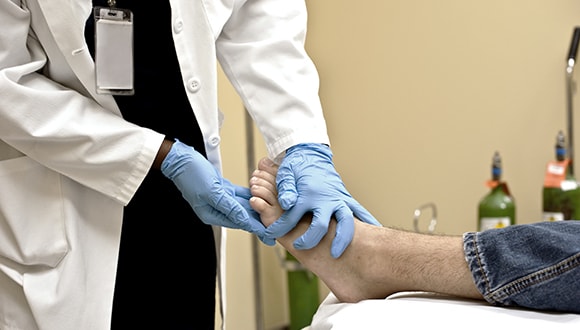Diabetes and Feet: Why 80% of amputations are preventable
When it comes to diabetes and feet problems, prevention is key. Here’s how to stay one step ahead of diabetic foot disease.
Karen Burge
April 2019
Diabetic foot disease, which includes ulcers, infections and ischaemia (severe circulation restriction), is Australia’s leading cause of amputations – and is in the top 20 causes of all hospitalisations. Mortality rates are higher than many cancers and a limb is lost every 3 hours, according to a report in the Medical Journal of Australia.
But there are ways to prevent foot problems from spiralling out of control.
According to Diabetic Foot Australia, 80% of diabetes-related amputations are preventable with good management and ongoing care.
The connection between diabetes and feet problems
About 1.7 million Australians have diabetes, and damage to nerves in the feet is a common complication for people with this disease. The damaged nerve function is known as ‘peripheral neuropathy’ and about half of all people with diabetes (type 1 or 2) will have some form of it, reports Diabetic Foot Australia.
It can result in pain, tingling, weakness or reduced feeling in the feet and lower limbs, causing an abnormal walking pattern and creating pressure on certain parts of the foot.
New calluses might develop, giving an early warning sign, but it’s the continued abnormal walk that increases the chance of it turning into a sore. If feeling to the area is reduced, pain can go unnoticed and a person might not detect warning symptoms. Without adequate circulation, healing is also impeded.
A report published in Diabetes Care explains that in up to 50% of patients, this diabetic nerve damage may be asymptomatic, which means there are no obvious signs. This makes regular foot checks essential.
Preventing diabetic foot disease
Co-chair of Diabetic Foot Australia and author of the Medical Journal of Australia report, Dr Peter Lazzarini, says the most important thing people with diabetes can do for their feet is to have an annual check-up to find out if they have any risk factors for foot disease.
“This foot screen can be done quickly and painlessly by visiting a GP or podiatrist,” he says. “[They] will test your feet to see if you have any poor feeling (peripheral neuropathy) or poor circulation (peripheral arterial disease, which can lead to ischaemia).”
According to Dr Lazzarini, if you don’t have either of these risk factors, your level of risk for developing foot disease in the next year is low. You may be able to stick to annual check-ups unless you have any concerns.
But if these risk factors are picked up, Dr Lazzarini says you may need regular preventive care every few months at your podiatrist or GP. You’ll also need to check your own feet daily.
“The podiatrist [or doctor] will check to see if your feet have any early damage and treat that early damage (such as calluses, corns or blisters) before it may lead to foot disease and, in particular, foot ulcers,” he explains.
They can advise on appropriate footwear and perhaps insoles to help protect your feet from damage.

The early warning signs and symptoms of diabetic foot disease
As the condition progresses, there are opportunities to bring diabetes under control before it impacts your feet. The signs include high blood glucose levels, high blood pressure and high cholesterol, Dr Lazzarini says.
“It’s the high blood glucose levels in particular that, over time, really do the damage to the nerves and blood vessels in the feet.”
Also, see your GP regularly to monitor and manage your diabetes. Your doctor may suggest strategies to help you stay healthy, including a diet and exercise plan, home monitoring of blood glucose levels, referring you to other health experts or starting/increasing medication to keep your diabetes under control.
Tips for looking after diabetic feet
It’s important to keep on top of a daily foot-care routine. Diabetic Foot Australia recommends you practise a ‘check, wash, watch’ routine before your shower or at bedtime.
- Check for damage, which includes ulcers, sores, cuts, bruises and new callouses. Feel your feet, paying attention to any numbness or tingling. Check your foot temperature to see if there are any hot or cold changes across your foot.
- Wash daily using soap, dry thoroughly, and ask for help if you can’t reach.
- Watch includes managing your overall diabetes, maintaining toenail health, wearing good shoes and avoiding sudden temperature changes, such as walking on hot ground.
See a health professional straight away if you notice any changes to your feet. For more information on managing diabetes, visit Diabetes Australia.
Related articles
ADDRESSING DIABETES: A DUAL APPROACH
At HCF, we’re tackling this issue by investing in research and providing access to tailored health management programs.
Should I get my blood pressure checked?
How blood pressure works, and what the normal ranges are.
Cholesterol: What you should know
Understand the different types of cholesterol and how they affect your heart health.
Finding the right sports shoe for you
Want to get active but overwhelmed by all the types of sports shoe? Here’s some expert advice on finding the right fit.